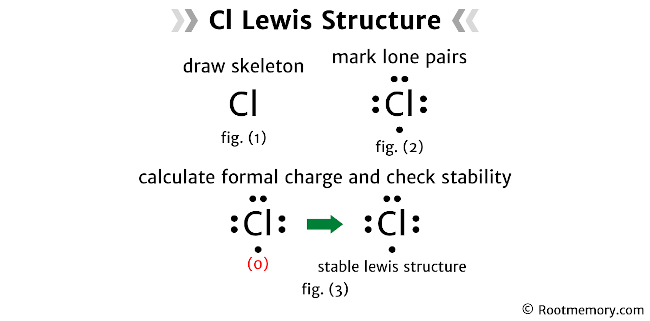
The Lewis structure of Cl contains one chlorine atom having three lone pairs and one unpaired electron on it.
Alternative method: Cl Lewis structure
Steps
Draw skeleton
In this step, first calculate the total number of valence electrons. And then, decide the central atom.
- Let’s calculate the total number of valence electrons
We know that… chlorine is a group 17 element. Hence, chlorine has seven valence electrons.
Now Cl has one chlorine atom.
Therefore, the total number of valence electrons = valence electrons of chlorine atom = 7
- Now decide the central atom
There is only one atom in Cl. Hence, assume that chlorine is the central atom.
So now, draw the rough skeleton structure for the Lewis structure of Cl something like this:

Also read: How to draw Lewis structure of S2Cl2 (4 steps)
Mark lone pairs
As calculated earlier, we have a total of 7 valence electrons.
Two valence electrons represent one lone pair. So six valence electrons = three lone pairs. Also, we have one unpaired electron.
Note that chlorine is a period 3 element, so it can keep more than 8 electrons in its last shell.
Also, make sure that you start marking these lone pairs on outside atoms first. And then, on the central atom.
There is no outside atom. So the central atom (chlorine) will get three lone pairs and one unpaired electron.
Now draw the Lewis structure of Cl looks something like this:

In the above structure, you can see that the central atom (chlorine) doesn’t form an octet.
But in the Lewis structure of Cl, chlorine has an exception that it does not require eight electrons to complete its octet.
Now one last thing we need to do is, calculate the formal charge and check the stability of the above structure.
Also read: How to draw Lewis structure of XeF6 (4 steps)
Calculate formal charge and check stability
The following formula is used to calculate the formal charges on atoms:
Formal charge = valence electrons – nonbonding electrons – ½ bonding electrons
Collect the data from the above structure and then, write it down below as follows:
- For chlorine atom
Valence electrons = 7
Nonbonding electrons = 7
Bonding electrons = 0
Formal charge = 7 – 7 – ½ (0) = 0
Mention the formal charge on the structure. So the Lewis structure of Cl looks something like this:

In the above structure, you can see that the formal charge of chlorine is zero. Therefore, this is the stable Lewis structure of Cl.
Next: Lewis structure of S2Cl2
Related
- Lewis structure of S2Cl2
- Lewis structure of XeF6
- Cl– Lewis structure
- Lewis structure of IBr
- Lewis structure of SbF5
External video
- Lewis Dot Structure for Chlorine Atom (Cl) – YouTube • Wayne Breslyn
External links
- How do you determine the Lewis Structure of Cl? – Quora
- What are all the Lewis symbols for Cl? – Socratic
- Draw the Lewis structure for Cl and its ion – Chegg
- Correct lewis dot structure for chlorine (Cl)? – Brainly
Deep
Rootmemory.com was founded by Deep Rana, who is a mechanical engineer by profession and a blogger by passion. He has a good conceptual knowledge on different educational topics and he provides the same on this website. He loves to learn something new everyday and believes that the best utilization of free time is developing a new skill.
